5.2 Thunderstorm Hazards: Lightning and Tornadoes
Discuss how lightning and tornadoes form and the hazards that each presents.
All thunderstorms are potentially dangerous. The two particularly hazardous phenomena produced by thunderstorms are lightning and tornadoes.
Lightning
Lightning is one of nature’s most awe-
lightning
An electrical discharge produced by thunderstorms.
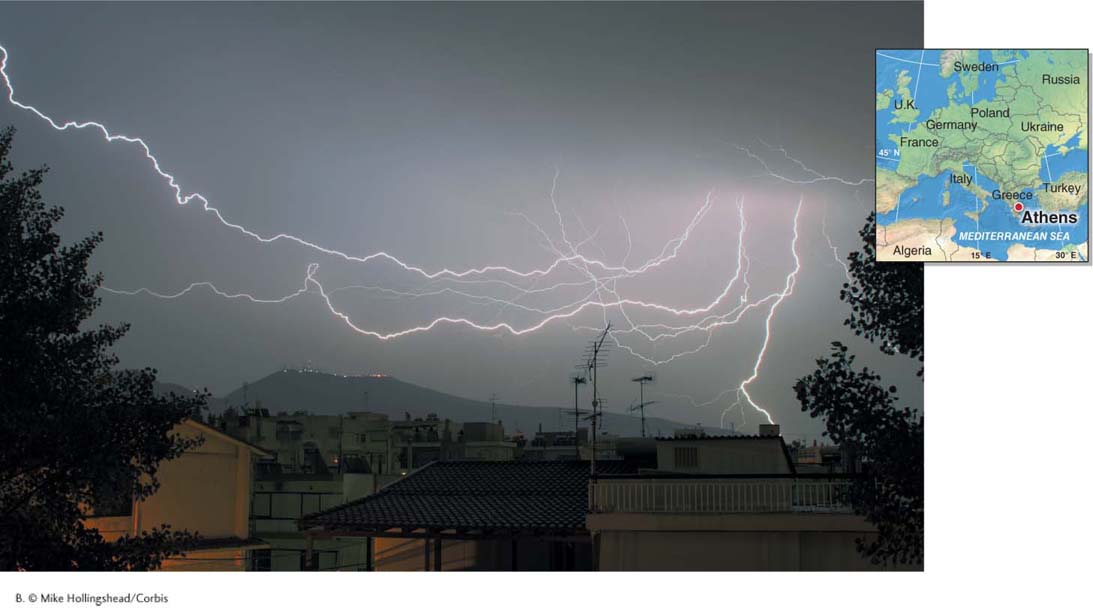
Question 5.2
How wide is a bolt of lightning?
A bolt of lightning is about 2.5 cm (1 in) in diameter.
A bolt of lightning is about or 54,000°F). The air around a lightning bolt becomes superheated and expands explosively, creating an acoustic shock wave called thunder.
thunder
An acoustic shock wave produced when lightning rapidly heats and expands the air around it.
When lightning strikes the ground, it follows channels of least resistance, particularly through objects with a high water content, such as wet soil or tree roots. Its path can be seen when the heat of lightning fuses silica in sand into a glassy hollow tube called a fulgurite, as shown in Figure 5.9.
fulgurite
A glassy hollow tube formed where lightning strikes sand.
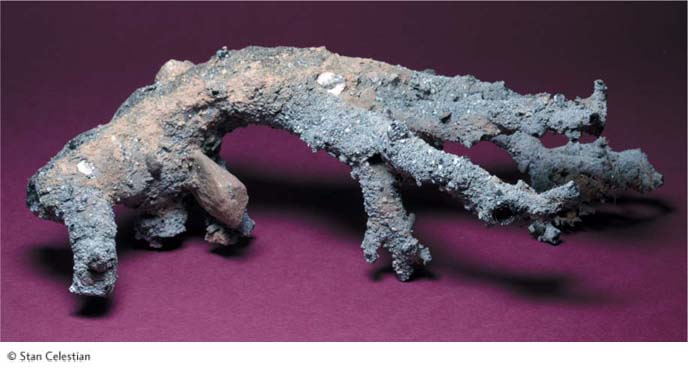
What Causes Lightning?
Lightning is formed as cumulonimbus clouds develop a separation of electrical charges. As rain, ice crystals, and hail within the cloud collide, friction creates negative and positive charges within these particles. Larger particles become negatively charged and smaller particles become positively charged. With the assistance of air turbulence, lighter ice crystals with a positive charge migrate upward in the cloud, and heavier particles, such as rain and hail, with a negative charge migrate to the lower parts of the cloud (Figure 5.10).

Normally, Earth’s surface has a negative charge, and the upper atmosphere has a positive charge. Because of the negative charge at the base of the thunderstorm, a positive charge follows along the ground beneath a thunderstorm like a shadow. Objects that protrude above the ground, such as buildings and trees, develop the strongest positive charge.
Air is an insulator and inhibits the flow of electricity. As a result, the opposite electrical charges between the cloud and ground, or within the cloud, build up to tens of millions of volts. Eventually, two oppositely charged regions develop an electrical connection, and a bolt of lightning is discharged. This discharge equalizes the electrical charges for a short while. Soon, however, another pair of opposite charges builds up and results in another lightning discharge.
Staying Safe in Lightning
Being caught outside in lightning is an unforgettable and potentially deadly experience. About 500 people are struck by lightning each year in the United States, mostly in Florida. Only about 10% of lightning-

Light travels at a speed of 300,000 km (186,000 mi) per second. Thus, the light from a flash of lightning reaches our eyes almost instantly. The speed of sound is much slower, however, and depends on characteristics of the atmosphere. At sea level, sound travels at about 343 m (or 1,120 ft) per second. Because of the time lag between the lightning discharge and the sound of thunder, it is possible to calculate the distance of a bolt of lightning (Crunch the Numbers).
The 30/30 rule of lightning safety states that it is not safe to go outdoors if lightning is within 10 km (6 mi) of your location (30 seconds between lightning and thunder) and that it is best to wait until 30 minutes after the storm has passed to go back outside. In some cases, lightning is too distant for thunder to be heard, resulting in silent flashes of what is often called heat lightning.
Tornado!
Most tornadoes form in supercell thunderstorms, but tornadoes can also form in hurricanes and cold fronts. Meteorologists do not yet understand why only about 25% of supercell thunderstorms produce tornadoes. If a tornado does form, it usually descends from a wall cloud, a cylindrical cloud that protrudes from the base of the mesocyclone (Figure 5.12). Scientists still do not know how tornadoes form in a supercell thunderstorm.
wall cloud
A cylindrical cloud that protrudes from the base of a supercell thunderstorm.
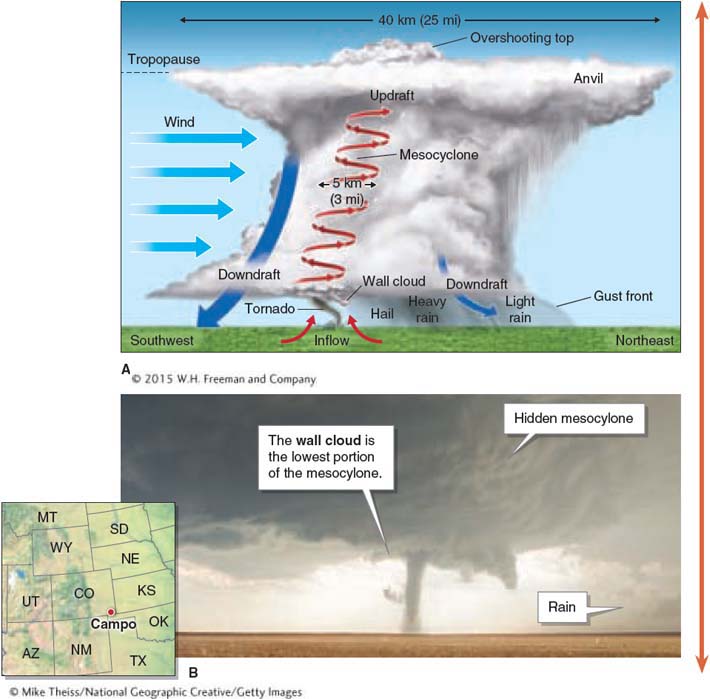
CRUNCH THE NUMBERS: Calculating Lightning Distance
CRUNCH THE NUMBERS: Calculating Lightning Distance
After you see a flash of lightning, begin counting in seconds until you hear the sound of thunder. Using the speed of sound at sea level given in the text, determine how far away the lightning is by the length of time it took the sound to travel between the lightning and your position. (To convert meters to kilometers, divide by 1,000. To convert feet to miles, divide by 5,280.) If you count 15 seconds, how many kilometers (or miles) away is the lightning?
A tornado is a violently rotating column of air that descends from a cumulonimbus cloud and touches the ground. A funnel cloud is a rotating column that descends from a cumulonimbus cloud but is not in contact with the ground. Tornadoes are ranked using the enhanced Fujita scale (EF scale) (Figure 5.13A). Tornado strength is estimated by the damage done to the landscape. As with many natural phenomena, the frequency and intensity of tornadoes are inversely related: There are many low-
tornado
A violently rotating column of air that descends from a cumulonimbus cloud and touches ground.
enhanced Fujita scale (EF Scale)
A system used to rank tornado strength based on damage done to the landscape.

Most tornadoes in the United States cause only light to moderate damage, and they stay on the ground no longer than 5 minutes. The months of April through July are the most active period for tornadoes (Table 5.1).
|
CHARACTERISTIC |
TYPICAL |
UNUSUAL |
|---|---|---|
|
Time of year |
April– |
Winter |
|
Time of day |
4:00 to 6:00 p.m. |
Early morning |
|
Diameter |
50 m (160 ft) |
1.5 km (1 mi) |
|
Forward movement speed |
48 km/h (30 mph) |
113 km/h (70 mph) |
|
Length of ground path |
3 km (2 mi) |
480 km (300 mi) |
|
Duration |
5 minutes |
Up to 6 hours |
Tornado Geography
Question 5.3
Do tornadoes ever strike the same place twice?
Codell, Kansas, was struck by tornadoes three years in a row, in 1916, 1917, and 1918, all on May 20.
Tornadoes do strike the same place twice. Despite very low odds, Codell, Kansas (current population about 2,700), was struck by tornadoes three years in a row—
The United States has the highest frequency of tornadoes and the strongest tornadoes in the world (Figure 5.14A). The United States experiences about 1,200 tornadoes each year, the highest number of any country. Canada ranks second in tornado frequency for any country, with about 100 per year on average.
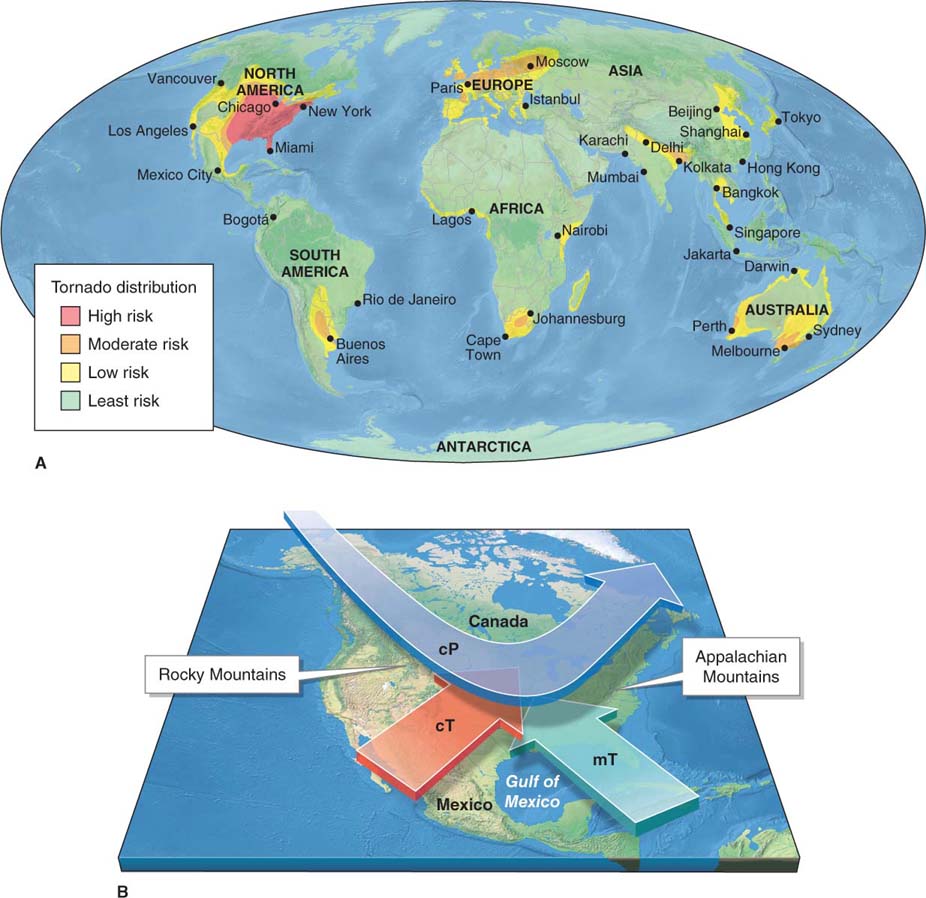
Because Florida experiences the most thunderstorm days per year, it also experiences the most tornadoes (4.7 per 10,000 km2 or 3,860 mi2). The majority of these are EF0 and EF1 tornadoes. Kansas, on the Great Plains, experiences the second highest frequency of tornadoes (4.5 per 10,000 km2). Because the Great Plains are relatively flat, warm and humid mT air masses from the south interact there with dry and cold air masses from the west and north. In most other parts of the world, mountain ranges keep these air masses separate. Most EF4 and EF5 tornadoes in the United States occur between the Rocky Mountains and the Appalachian Mountains as far north as the Dakotas (Figure 5.14B).
Warning the Public, Saving Lives
When a tornado touches ground in the United States, the National Weather Service issues an alert. Tornado sirens sound the alarm, and all media channels, including TV, radio, and the Internet, broadcast the alert. These alerts have saved many thousands of lives since they were first implemented in the mid-
A tornado watch is issued hours in advance of a possible storm to help people prepare. Watches are issued when conditions are favorable for tornadic thunderstorms. A tornado warning is issued when a tornado or funnel cloud has been seen and called in to local authorities or when a strong near-
tornado watch
An alert issued by the National Weather service when conditions are favorable for tornadic thunderstorms.
tornado warning
A warning issued by the National Weather Service after a tornado has been seen and called in to local authorities or when one is suggested by a Doppler radar hook echo signature.
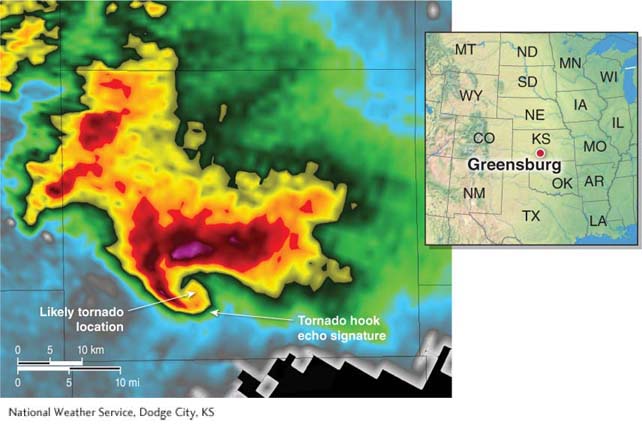
The most important element in staying safe during a tornado is early warning. Those living where powerful tornadoes are possible should always have a two-
|
WHAT TO DO |
WHAT TO AVOID |
|---|---|
|
Indoors |
|
|
Retreat to a basement or interior room or hallway. |
Windows, which are easily shattered into dangerous glass shards. |
|
Retreat to the lowest refrigerators, which can fall on a person. |
Heavy objects such as floor. |
|
Crouch in a bathtub. |
Exterior walls, which can fail in high winds. |
|
Cover yourself with a mattress or sleeping bag. |
Mobile homes, even those with anchored foundations, are unsafe in a tornado. |
|
Outdoors |
|
|
Find low ground and lie facedown with arms over head. |
Cars. If caught in a car, park on the side of road. Keep seat belt on, and put head down below the windows. |
|
|
Bridges. Wind speed increases under bridges. |